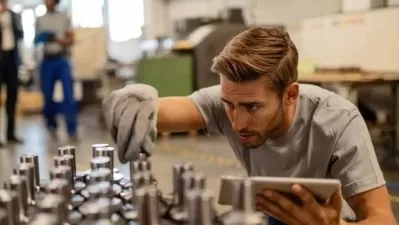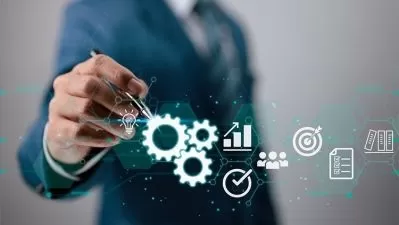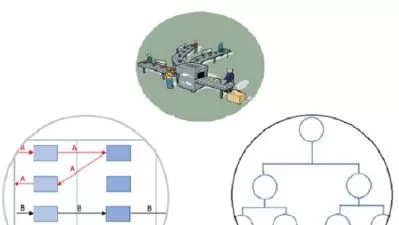Introduction to process control and instrumentation
WR Training
3:06:08
Description
Learn how process control is ensured in process industries & how the main instruments measure the key process variables
What You'll Learn?
- Learn the essentials of process control and instrumentation for a successful career in process industries
- Understand the main terms and parameters of process control (Process variable PV, Set point SP, Operating point OP, Error, Offset, Load disturbance...)
- Identify the different control loops and describe their main tasks
- Describe the basic function & method of operation for the main control loop components (Transducer, Converter, Transmitter, Indicator, Recorder, Controller...)
- Given a piping and instrumentation drawing (P&ID), correctly identify, interpret and label the instrument, location and signal type symbols
- Differentiate between discrete, multistep, and continuous controllers
- Describe the general goal of controller tuning
- Describe the basic mechanism, advantages and disadvantages of the following mode of controller action : Proportional, Integral and Derivative
- Identify the basic implementation of P, PI and PID control in the following types of loops : Pressure, Flow, Level and Temperature loops
- Differentiate feedback and feedforward control loops
- Diagram the process control loop using ISA symbology
- Explain the basic implementation process for each of the following types of control : Cascade, Split range , Batch, Ratio and Selective controls
- Understand through extensive 3D animation the techniques and methods used in process industries to measure temperature, pressure, flow and level
Who is this for?
What You Need to Know?
More details
Description-----------------------------------------
COURSE UPDATE:
We have added quizzes to help you test your knowledge and emphasize the key learning points. The quizzes include:
True/False questions
Multi-choice questions
Images, cross-sectionnal views
Solved problems
and much more...
When you think you’ve got a good grasp on a topic within the course, you can test your knowledge by taking the quizzes. If you pass, wonderful ! If not, you can review the videos and notes again or ask us for help in the Q&A section.
-----------------------------------------
Dear student,
Control in process industries refers to the regulation of all aspects of the process. Precise control of level, temperature, pressure and flow is important in many process applications.
This course introduces you to control in process industries, explains why control is important, identifies different ways in which precise control is ensured and illustrates the different set of instrumentation used to perform measuring tasks for temperature, pressure, flow and level.
The course includes extensive graphics, cut sections, process schemes and 3D animations to give you a virtual practical exposure on process control and instrumentation.
The objective of this course is twofold :
1. Break down for you all the process control and instrumentation principles into easily digestible concepts like feedback control, split range, controller tuning, transmitters, differential pressure gauges, etc...
2. Illustrate through 3D animations and cut-sections the main control instrument devices to measure temperature, pressure, flow and level like thermocouples, capacitive pressure gauges, coriolis flowmeters, etc...
As you proceed through the course, answer the questions in the attached pdf quiz files. These files are available at the end of each section.
We strongly advise you to do so before moving on in the course. Quiz exercises help you measure your progress toward meeting each section’s learning objectives.
If you pass, wonderful. If not, you can review the videos and notes again or ask us for help in the Q&A section.
So with no further ado, check out the free preview videos and the curriculum and we look forward to see you in the first section.
Also remember, as enrolled student you will have unlimited access to this material and one-on-one instructor support. So feel free to interact with us by email or simply ask us for help in the Q&A section. It will be our pleasure to help you and provide assistance.
Hope to see you there
Cheers,
WR Training
Spread the wings of your knowledge
Who this course is for:
- Personnel needing to learn the essentials of process control and instrumentation
- Control, Process, Chemical and Design Engineers
- Operation, technical service and maintenance professionals
- Experienced personnel as a refresher course and to broaden their knowledge
- Consultants and Sales professionals
-----------------------------------------
COURSE UPDATE:
We have added quizzes to help you test your knowledge and emphasize the key learning points. The quizzes include:
True/False questions
Multi-choice questions
Images, cross-sectionnal views
Solved problems
and much more...
When you think you’ve got a good grasp on a topic within the course, you can test your knowledge by taking the quizzes. If you pass, wonderful ! If not, you can review the videos and notes again or ask us for help in the Q&A section.
-----------------------------------------
Dear student,
Control in process industries refers to the regulation of all aspects of the process. Precise control of level, temperature, pressure and flow is important in many process applications.
This course introduces you to control in process industries, explains why control is important, identifies different ways in which precise control is ensured and illustrates the different set of instrumentation used to perform measuring tasks for temperature, pressure, flow and level.
The course includes extensive graphics, cut sections, process schemes and 3D animations to give you a virtual practical exposure on process control and instrumentation.
The objective of this course is twofold :
1. Break down for you all the process control and instrumentation principles into easily digestible concepts like feedback control, split range, controller tuning, transmitters, differential pressure gauges, etc...
2. Illustrate through 3D animations and cut-sections the main control instrument devices to measure temperature, pressure, flow and level like thermocouples, capacitive pressure gauges, coriolis flowmeters, etc...
As you proceed through the course, answer the questions in the attached pdf quiz files. These files are available at the end of each section.
We strongly advise you to do so before moving on in the course. Quiz exercises help you measure your progress toward meeting each section’s learning objectives.
If you pass, wonderful. If not, you can review the videos and notes again or ask us for help in the Q&A section.
So with no further ado, check out the free preview videos and the curriculum and we look forward to see you in the first section.
Also remember, as enrolled student you will have unlimited access to this material and one-on-one instructor support. So feel free to interact with us by email or simply ask us for help in the Q&A section. It will be our pleasure to help you and provide assistance.
Hope to see you there
Cheers,
WR Training
Spread the wings of your knowledge
Who this course is for:
- Personnel needing to learn the essentials of process control and instrumentation
- Control, Process, Chemical and Design Engineers
- Operation, technical service and maintenance professionals
- Experienced personnel as a refresher course and to broaden their knowledge
- Consultants and Sales professionals
User Reviews
Rating
WR Training
Instructor's Courses
Udemy
View courses Udemy- language english
- Training sessions 74
- duration 3:06:08
- English subtitles has
- Release Date 2024/04/29










